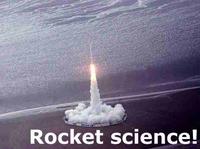Three persons were particularly significant in the transition from the small rockets of the 19th century to the colossi of the space age: Konstantin E. Tsiolkovsky in Russia, Robert H. Goddard in the United States, and Hermann Oberth in Germany. It is generally agreed that priority goes to Tsiolkovsky (1857-1935), who apparently in his teens became interested in the possibility of spaceflight.
He was a sickly boy, often bedridden with tuberculosis, who passed the time with fantastical stories by Jules Verne and H.G. Wells that made his mind imagine otherworldly exploration.
But for Robert Goddard, who would become the founding father of rocket science decades before men were sent to the moon, traveling to places far from Earth wasn’t just the stuff of fiction.
In 1899, Goddard became convinced it was possible to blast a rocket into space, and began pursuing physics to prove his theory. He was 17
The scientific papers he started publishing attracted attention from the media, which quickly dismissed Goddard as a mad scientist without a prayer of proving his theories.
A few days before the first manned moon landing in 1969, The New York Times ran a correction about a story they published 49 years earlier mocking Goddard’s theories.
Hermann Julius Oberth, born June 25, 1894 in the Transylvanian town of Hermannstadt, is, along with the Russian Konstantin Tsiolkovsky and the American Robert Goddard, one of the three founding fathers of rocketry and modern astronautics. Interestingly, although these three pioneers arrived at many of the same conclusions about the possibility of a rocket escaping the earth’s gravitational pull, they seem to have done so without any knowledge of each other’s work.
Oberth’s interest in rocketry was sparked at the age of 11. His mother gave him a copy of Jules Verne’s From The Earth To The Moon, a book which he later recalled he read “at least five or six times and, finally, knew by heart.” It was a young Oberth, then, that discovered that many of Verne’s calculations were not simply fiction, and that the very notion of interplanetary travel was not as fantastic as had been assumed by the scientific community.
Wernher von Braun (1912-1977) was one of the most important rocket developers and champions of space exploration during the period between the 1930s and the 1970s. As a youth he became enamored with the possibilities of space exploration by reading the science fiction of Jules Verne and H.G. Wells, and from the science fact writings of Hermann Oberth, whose 1923 classic study, Die Rakete zu den Planetenraumen (By Rocket to Space), prompted young von Braun to master calculus and trigonometry so he could understand the physics of rocketry.
Early Days of Rocket and Aeronautics
The History of Rocket Science
Rocket Science 101
How Rocket Engines Work
So you’d like to be a Rocket Scientist?
Rocket Motion
Rocket Propulsion
Take Formula-1, multiply the speed by 10 (just to start), add in metal melting 3000 degree exhaust plumes of pure flame, acceleration of 0 to Mach 2.4 in 2.5 seconds, and aerospace technologies, and you’re talking the most extreme of extreme forms of transport…. Rocket Power!
Model Rocket Information
Build Your Own Solid Rocket Motors? DANGER DANGER DANGER
This isn’t rocket science
What do rocket scientists say when they want to describe a portion of their work as easy?

